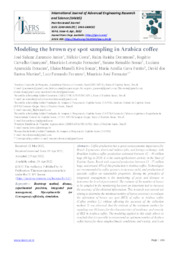Modeling the brown eye spot sampling in arabica coffee.
Modeling the brown eye spot sampling in arabica coffee.
Author(s): ZANUNCIO JUNIOR, J. S.; COSTA, H.; DORZENONI, R. R.; GUARÇONI, R. C.; FORNAZIER, M. L.; SOSSAI, S. R.; BOTACIM, L. A.; SOUZA, E. M. R.; FERRAO, M. A. G.; MARTINS, D. dos S.; FAVARATO, L. F.; FORNAZIER, M. J.
Summary: Coffee production has a great socioeconomic importance for Brazil. It generates direct and indirect jobs, and foreign exchange, with Brazilian Arabica coffee production estimated between 42 - 46 million bags (60 kg) in 2020. It is the main agribusiness activity in the State of Espírito Santo, Brazil with expected production between 13 - 15 million bags, and around 30% of this production is Arabica coffee. Technologies are recommended to coffee growers to increase yield, and production of specialty coffees on sustainable properties. Among the principles of integrated management is the monitoring of pests and diseases to determine the level of pest control. The estimate of the number of leaves to be sampled in the monitoring becomes an important tool to increase the accuracy of the obtained information. This research was carried out aiming to determine the minimum number of leaves necessary to evaluate the infestation of brown eye spot (BES) of coffee in Arabica coffee (Coffea arabica L.) without affecting the accuracy of the collection method. It was observed that the estimate of the minimum number for sampling was 46 leaves for the characteristics of incidence, and severity of BES in Arabica coffee. The modeling applied in this study allows to conclude that it is possible to recommend an optimum number of Arabica coffee leaves for these edaphoclimatic conditions, and variety, and it can serve as a basis for monitoring in an integrated pest and disease management program in Arabica coffee.
Publication year: 2022
Types of publication: Journal article
Unit: Embrapa Coffee
Observation
Some of Embrapa's publications are published as ePub files. To read them, use or download one of the following free software options to your computer or mobile device. Android: Google Play Books; IOS: iBooks; Windows and Linux: Calibre.
Access other publications
Access the Agricultural Research Database (BDPA) to consult Embrapa's full library collection and records.
Visit Embrapa Bookstore to purchase books and other publications sold by Embrapa.

